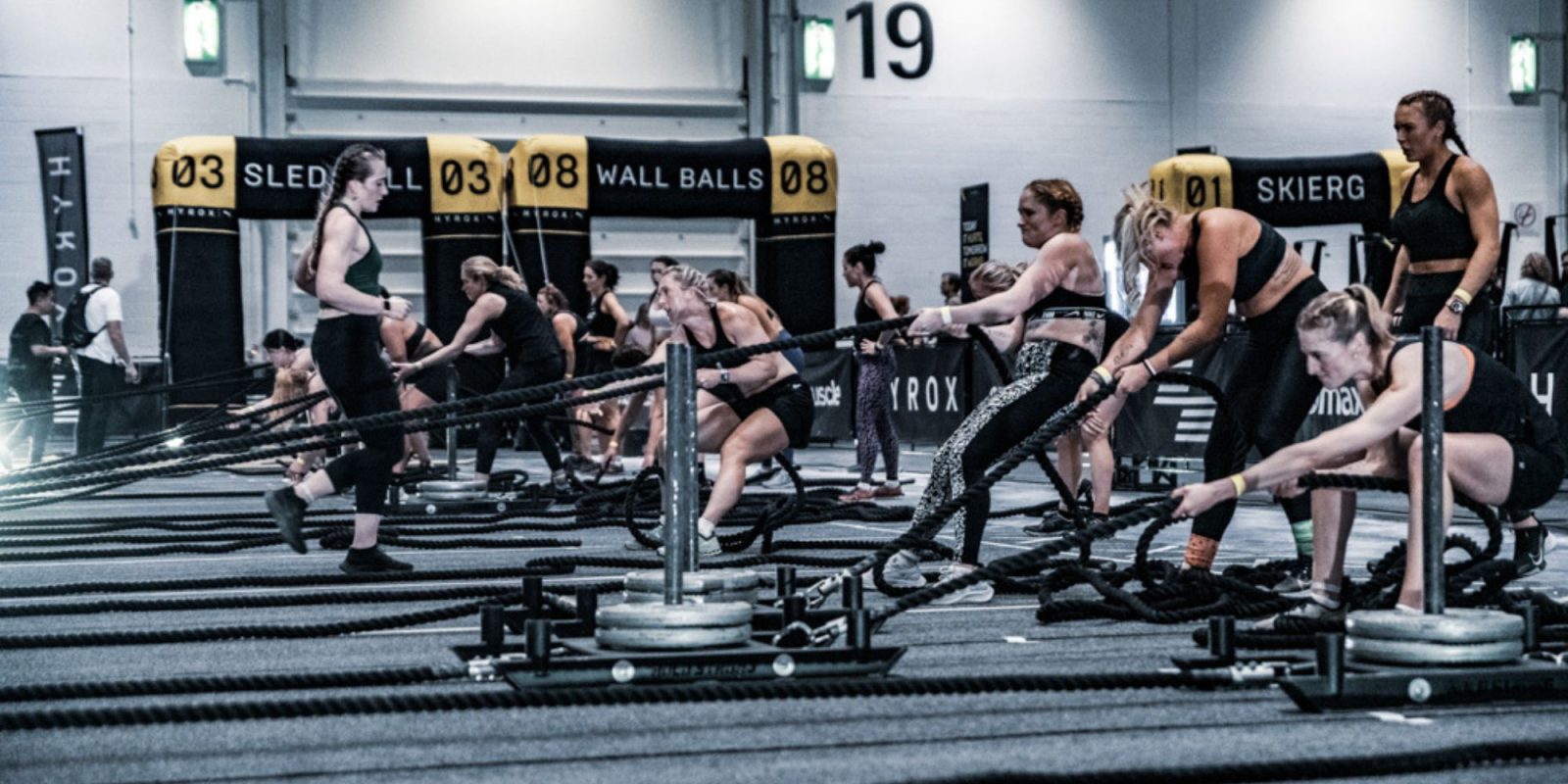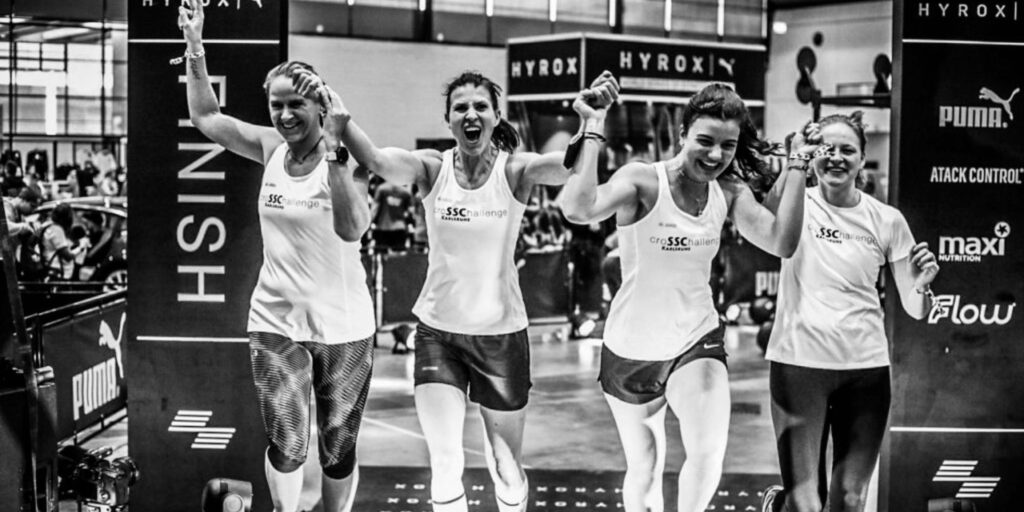
On its surface, HYROX looks like a fairly straightforward fitness race: eight 1k runs mixed alongside eight unique workout stations. However, this simplicity can be misleading. If you show up unprepared, HYROX can punish you in very specific ways, and small mistakes can quickly add up!
Here’s a breakdown of the 10 most common HYROX mistakes, and exactly how to avoid them so you can cross the finish line faster, stronger, and with enough left in the tank to actually enjoy it.
1. Always training the runs and stations separately
Why it’s a problem: Plenty of newcomers train running and station work in isolation, logging miles one day and hitting the sled the next. But HYROX fatigue doesn’t come from running alone or strength alone. It’s the cumulative effect of switching between them over and over.
How to fix it: Incorporate “compromised running” into your training: run 500–1000m, then immediately hit a station movement (like sled push or wall balls), then run again. Variations like this condition your body to handle the heart rate spikes and muscle fatigue that make HYROX unique.
2. Underestimating the run
Why it’s a problem: The stations get a lot of attention, but HYROX is still more of a running event than anything else. If your aerobic engine is underdeveloped, being really strong won’t really help you that much.
How to fix it: Spend at least 2-3 days per week building steady-state cardio at an easy pace, in addition to higher intensity interval sessions. This low-intensity work will help you build your aerobic base is that you can better sustain a steady pace between stations.
3. Overestimating raw strength
Why it’s a problem: HYROX isn’t a 1-rep max test… it’s a grind. The sleds, lunges, and carries can feel heavy under fatigue, but are more designed to be moved repeatedly at sub-maximal effort. Having a massive squat 1-rep max won’t save you if you can’t push a sled for 50m without taking long breaks.
How to fix it: Spend a lot of time training with race loads and distances. Focus on strength endurance: moderate weight, perfect form, and smaller rest periods.
4. Mismanaging the sled push and pull
Why it’s a problem: The sled stations are where most athletes lose huge chunks of time, and it’s not always about strength. Bad technique, poor footwear choice, and inefficient pacing can turn these into multi-minute disasters.
How to fix it: Practice technique as much as raw effort: keep a low body position for the push, consistent grip for the pull. Use footwear with solid traction, and break the station into sustainable chunks instead of emptying the tank too early.
5. Treating all stations equally
Why it’s a problem: Every HYROX station taxes the body differently: ski erg hits the upper body and lungs, lunges crush the quads and glutes, farmers carries light up the grip. If you attack them all with the same pacing and recovery strategy, you’ll come away from the event with a much slower time than you could have.
How to fix it: Identify your personal “red zone” stations, the ones that spike your heart rate or fatigue you fastest, and train them more often. Pairing them with runs to learn how to probably pace and recover from them while moving.

6. Poor pacing in the runs
Why it’s a problem: The temptation to hammer the first run is strong (especially when adrenaline is high), but HYROX rewards steady effort, not hero splits. A fast first 1K often turns the final 3K into a death march.
How to fix it: Train to run slightly slower than your 5K pace early in the race, with the goal of saving that energy for the last few runs. Use your watch or the in-venue clocks to keep yourself honest.
7. Underestimating transition time (The Roxzone Effect)
Why it’s a problem: In HYROX, the Roxzone is the official designation for the transition area between the running course and each workout station. It’s part of your official race time, but many of us treat it like a rest stop: walking slowly, grabbing extra drinks, or standing still to reset. Over eight stations, this can quietly add up to a ton of time without you realizing it.
How to fix it: Treat the Roxzone like an extension of the race itself. Practice flowing from a run into a station without hesitation. In training, set up your stations so you have to run or walk briskly into them, keeping transitions under 10 seconds. Use this space to get mentally set, adjust your breathing, and grab quick hydration, but never stop moving forward.
8. Not training under race-day fatigue
Why it’s a problem: You might nail wall balls in the gym fresh, but they feel completely different after 7K of running and seven stations. Same for burpee broad jumps when your hamstrings are fried.
How to fix it: Do full-course simulations at least twice before race day. Even a half-distance simulation will give you a much better feel for pacing, fueling, and recovery.
9. Improvising nutrition and hydration
Why it’s a problem: HYROX runs long enough (usually 90-150 minutes for beginners) that nutrition matters, but too many athletes wing it and suffer cramps, GI distress, or energy crashes.
How to fix it: Test your fueling plan in training. If you plan to take in carbs mid-race, practice it during longer runs or longer HYROX workouts so your stomach knows what to expect.
10. Focusing too much on the results
Why it’s a problem: HYROX is brutally honest about where your fitness is. Going into your first attempt, its is better to try and enjoy yourself, pace properly, and set an initial benchmark to try and beat in the future. Focusing too much on the results when you have never attempted it can make the event feel a lot more stressful than it needs to be.
How to fix it: Treat your first race as a benchmark. Aim for clean movement standards, sustainable pacing, and execution over speed. Use the result to build a smarter plan for your second event.
Suggested articles:
- HYROX vs DEKA: Which event is best for you?
- NordicTrack vs. Proform: Which bike should you buy?
- STEPR review: The Peloton of stair climbers!
FTC: We use income earning auto affiliate links. More.

